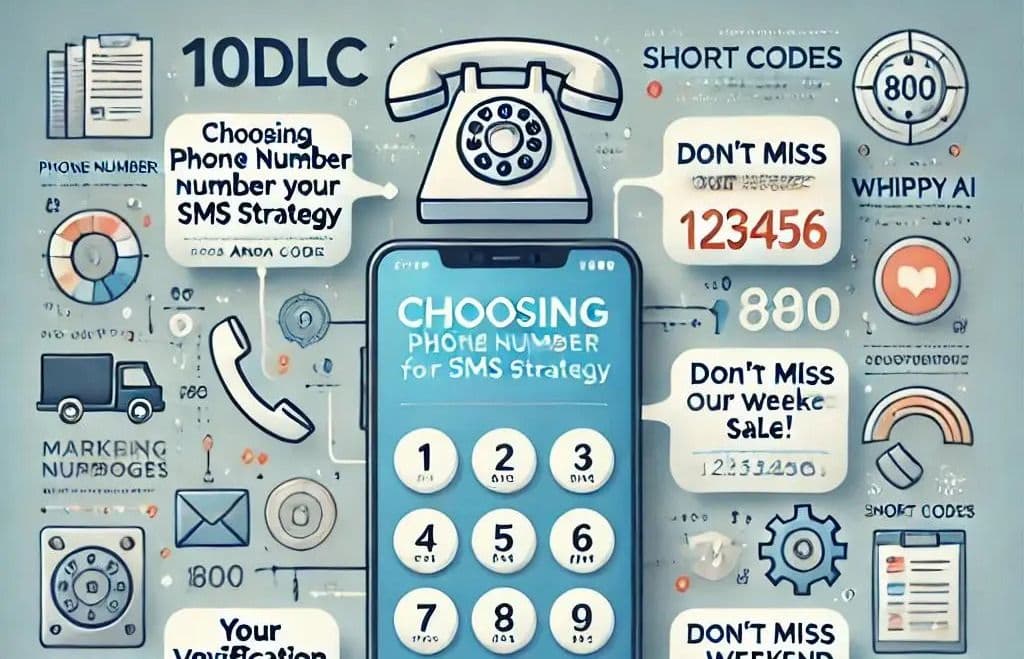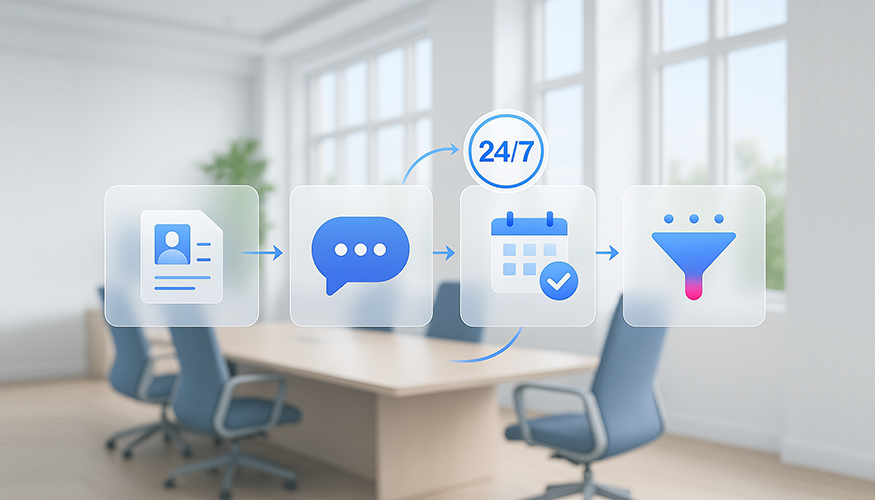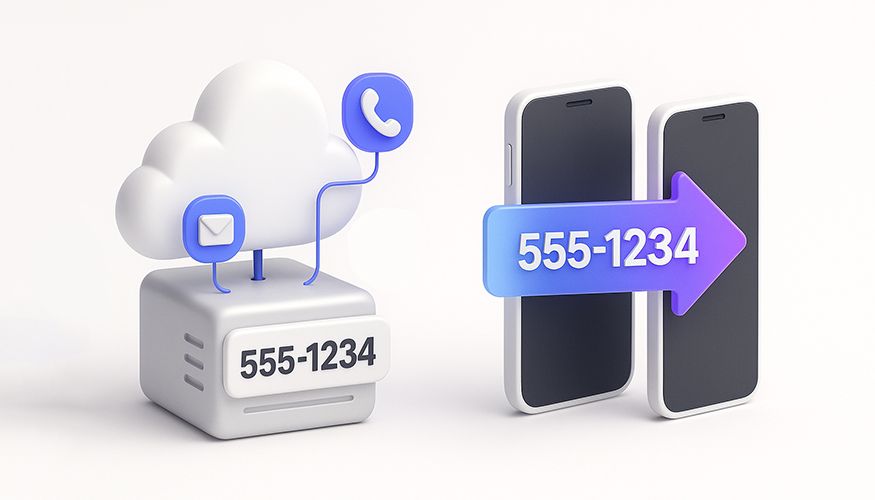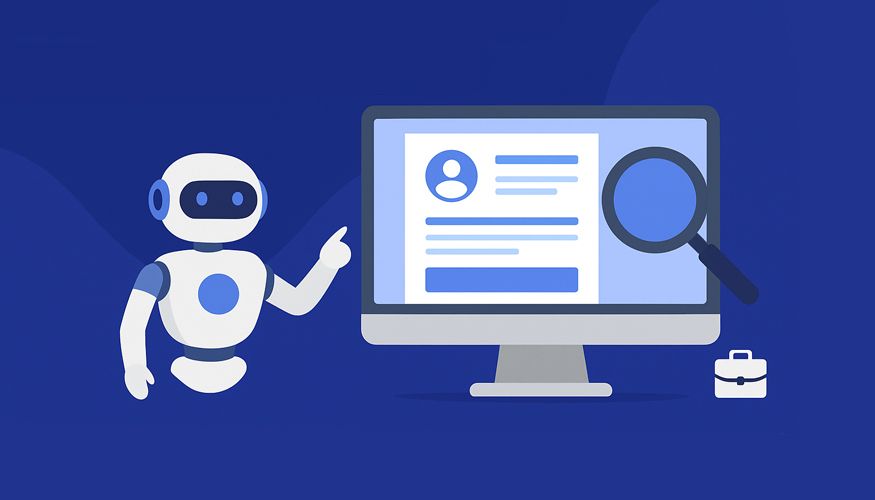Table of Contents
- Understanding SMS-Capable Phone Numbers
- Types of Phone Numbers in the USA
- 800 Numbers (Toll-Free SMS Numbers)
- Short Code Phone Numbers (Short Code SMS Services)
- How to Choose a Phone Number for SMS Marketing Campaigns?
- How to Choose a Phone Number for Sales?
- What Type of Phone Number Should I Use for SMS Customer Support?
- How to Get Phone Numbers for Bulk SMS?
- How to Generate Phone Numbers for Bulk SMS?
- Online Phone Numbers for SMS
- Considerations when using Phone Numbers for SMS
- Best Practices for SMS Marketing and Customer Support
- Conclusion
Try Whippy for Your Team
Experience how fast, automated communication drives growth.

Effective communication lies at the heart of every thriving business. With customers expecting instant responses and personalized interactions, SMS marketing for businesses and SMS for customer support have emerged as powerful tools, part of a modern business phone system that delivers voice, SMS, and automated workflows.
But what type of business SMS number should you use for customer support texting, an SMS marketing campaign, or bulk SMS for businesses? The choice of phone number can significantly impact the effectiveness of your business texting strategy.
At Whippy AI, we specialize in leveraging AI and automation within virtual phone systems to enhance customer experience and business communication. In this comprehensive guide, we'll delve deep into the types of phone numbers in the USA, their characteristics, and how to choose the best one for your business SMS platforms. We'll also address common questions like how to get phone numbers for bulk SMS, how to generate phone numbers for bulk SMS, and the use of online phone numbers for SMS marketing.
Understanding SMS-Capable Phone Numbers
An SMS-capable phone number is a number that can send and receive text messages in addition to making voice calls. These numbers are essential for businesses that want to engage with customers through business SMS solutions, notifications, or customer support texting. With high open rates and immediate delivery, SMS is a powerful channel for customer engagement.
Why use SMS?
📱 High Open Rates
Proven channel in business text messaging strategies with 98%+ open rates.
📱 Immediate Delivery
Messages are delivered instantly, making it ideal for time-sensitive information.
📱 Personalization
Allows for personalized communication, enhancing customer experience.
Types of Phone Numbers in the USA
Choosing among 10DLC, toll-free, and short codes is a key decision in your overall business phone system design. The main categories include:
- 10-Digit Long Codes (10DLC)
- 800 Numbers (Toll-Free SMS Numbers)
- Short Code Phone Numbers (Short Code SMS Services)
Each type has its unique features, benefits, and limitations. Let's explore them in detail.
10-Digit Long Code Phone Numbers (10DLC)
10DLC refers to standard 10-digit phone numbers used primarily for messaging. These numbers look like regular local phone numbers and are familiar to most consumers.
Characteristics of 10DLC Phone Numbers
- Area Code Association: They have specific area codes, making them appear local to recipients. This can build trust and increase engagement.
- Usage: Suitable for lower volume messaging, typically up to thousands of messages per day.
- Delivery Receipts: Provide confirmation of delivery to the carrier but not to the handset.
- Regulation: Require registration and compliance with A2P 10DLC Compliance, including providing Employer Identification Numbers (EIN) and undergoing vetting for a brand score.
10DLC Usage
10DLC numbers are ideal for businesses that:
- Want a Local Presence: Great for businesses serving specific regions.
- Send Personalized Messages: Ideal for transactional messages like appointment reminders or order confirmations.
- Operate Within Compliance Frameworks: Necessary for businesses that must adhere to strict regulatory standards.
10DLC Limitations
- Volume Constraints: Not suitable for high-volume SMS texting required in mass marketing campaigns.
- Filtering Issues: Messages may be filtered or blocked by carriers if not compliant.
- Regulatory Compliance: Requires adherence to specific registration processes, which can be time-consuming.
10DLC Example Usage
Imagine a local restaurant that wants to send reservation confirmations and special offers to its customers. Using a 10DLC number with the local area code can make customers feel more connected and increase the likelihood of engagement.
800 Numbers (Toll-Free SMS Numbers)
800 numbers are toll-free numbers commonly used for higher volume messaging across the United States. They are not associated with a specific geographic area.
Characteristics of Toll Free Numbers
- Volume: Capable of sending thousands of messages per minute, making them suitable for large-scale campaigns.
- Area Code: Lack specific area codes, which might be a disadvantage for businesses targeting local markets but advantageous for nationwide reach.
- Regulation: Requires toll-free SMS number registration, which is generally simpler and faster than 10DLC registration.
Toll Free Usage
Ideal for businesses that need to:
- Send bulk SMS quickly: Perfect for nationwide promotions or urgent notifications.
- Provide Nationwide SMS customer support: Ensures accessibility for customers across the country.
- Send Notifications and Alerts: Useful for banks or airlines sending time-sensitive information.
Toll Free Benefits
- High Throughput: Solves volume and speed issues associated with 10DLC.
- Cost-Effective: Generally more affordable than short codes for high-volume SMS campaigns.
- Professional Image: Enhances brand perception by providing a toll-free messaging number.
Toll Free Limitations
- Lack of Local Presence: May not be ideal for businesses focusing on local markets.
- Perceived as Impersonal: Some customers may perceive toll-free numbers as less personal.
Toll Free Example Usage Case
A nationwide retail chain wants to send promotional offers to its customers across different states. Using an 800 number allows them to reach a broad audience quickly without the constraints of local area codes.
Short Code Phone Numbers (Short Code SMS Services)
Short codes are special 5-6 digit numbers used for high-volume, time-sensitive messaging. They are easy to remember and are often used in SMS marketing campaigns, SMS polling, and secure SMS voting systems.
What are the Characteristics of Short Codes?
- Volume: Can send tens of thousands of messages per minute, ideal for large-scale campaigns.
- Cost: Expensive, with a base cost of around $1,000 per month plus setup fees.
- Usage: Commonly used by large brands for marketing campaigns, voting, and authentication messages.
- Vanity Short Codes: Customizable codes that can spell out a word or brand name for easy recall (e.g., Text "VOTE" to 12345).
When to use Short Code numbers?
Short code numbers are best suited for:
- Large Enterprises: Companies with significant messaging needs and budgets.
- Time-Sensitive Promotions: Ideal for flash sales or event notifications.
- Two-Factor Authentication: Provides quick and reliable message delivery for security purposes, and for One Time Passwords (OTPs).
Considerations when using Short Codes
- Regulation: Stringent requirements and approval processes can take weeks or months.
- High Cost: Not cost-effective for small businesses.
- Brand Recognition: Enhances brand visibility due to their uniqueness and memorability.
Short Code Example Use Case
A national TV show wants viewers to vote for contestants in real-time. Using a short code makes it easy for viewers to participate quickly by sending a text message to a memorable number.
How to Choose a Phone Number for SMS Marketing Campaigns?
Selecting the right phone number for your SMS marketing campaign depends on several factors:
1. Volume of Messages
📞 Low Volume: If you send fewer than 1,000 messages per day, a 10DLC number may suffice.
📞 High Volume: For sending thousands of messages per minute, consider an 800 number or short code.
2. Budget
📞 Limited Budget: 10DLC numbers are cost-effective.
📞 Flexible Budget: Toll-free numbers offer higher throughput at moderate costs.
📞 Large Budget: Short codes provide maximum impact but at a higher cost.
3. Audience Location
📞 Local Audience: Use 10DLC numbers to build local trust.
📞 Nationwide Audience: Toll-free SMS numbers or short codes are better for wide-reaching campaigns.
4. Compliance Requirements
📞 Regulatory Obligations: Ensure you understand and comply with registration and usage guidelines for each number type (e.g., A2P compliance).
5. Comparison Table

Steps to Choose
Assess Your Needs: Determine your messaging volume, target audience, and budget.
Consult with Providers: Speak to SMS service providers like Whippy AI to understand options.
Plan for Compliance: Factor in the time and resources needed for registration and compliance.
Test and Optimize: Consider running pilot campaigns to evaluate effectiveness.
How to Choose a Phone Number for Sales?
When choosing a phone number for sales communications:
Local Phone Numbers for Sales
10DLC Numbers: Using a local area code can build trust and increase answer rates for SMS sales outreach.
High-Volume SMS Outreach for Sales
800 Numbers: If your sales team makes a large number of outbound messages, a toll-free messaging number might be more efficient.
Phone Number Branding for Sales
Vanity Numbers: Consider a vanity toll-free SMS number that's easy to remember (e.g., 1-800-BUY-NOW).
SMS Integration with CRM
Ensure the number type you choose can integrate seamlessly with your Customer Relationship Management (CRM) system for tracking and analytics.
SMS Compliance for Sales
Be aware of regulations like the Telephone Consumer Protection Act (TCPA) and SMS compliance for businesses to avoid legal issues.
What Type of Phone Number Should I Use for SMS Customer Support?
For SMS customer support, responsiveness and reliability are key.
10DLC Numbers for Customer Support
- Advantages: Personal touch, local presence for customer support texting.
- Ideal For: Businesses with localized customer bases requiring personalized interactions.
800 Numbers for Customer Support
- Advantages: Handles higher message volumes, nationwide accessibility.
- Ideal For: Businesses with a broad customer base needing quick response times.
Short Code Numbers for Customer Support
- Advantages: High throughput, memorable for SMS polling.
- Limitations: Less personal, higher cost.
- Ideal For: Large enterprises handling massive support volumes.
Factors to Consider for Customer Support SMS
- Message Volume: Anticipate the number of support queries.
- Response Time: Ensure the number type supports quick message delivery.
- Customer Preferences: Some customers may prefer texting a local number over a toll-free one.
How to Get Phone Numbers for Bulk SMS?
Acquiring phone numbers for bulk SMS involves several steps:
1. Choose a Reputable SMS Service Provider
Select a provider like Whippy AI that offers:
- Variety of Number Types: Access to 10DLC, toll-free numbers, and short codes.
- Compliance Support: Assistance with registration and regulatory compliance.
- Scalability: Ability to handle your current and future messaging needs.
2. Register and Verify Your Business
- Documentation: Provide necessary business information, such as EIN and industry details.
- Compliance: Agree to terms of service and compliance requirements.
3. Select and Purchase Numbers
- Number Selection: Choose numbers that align with your business needs.
- Registration: Complete any required registration processes for 10DLC or toll-free numbers.
4. Set Up Your Messaging Platform
- Integration: Ensure the numbers are integrated into your messaging platform.
- Testing: Send test messages to verify functionality.
5. Build and Import Contact Lists
- Opt-In Contacts: Ensure you have permission to message your contacts.
- Segmentation: Organize contacts for targeted messaging.
How to Generate Phone Numbers for Bulk SMS?
Important Note: Generating random phone numbers to send bulk SMS is unethical and illegal under regulations like the TCPA and CTIA guidelines.
Ethical Ways to Build Contact Lists
- Opt-In Campaigns: Use marketing strategies to encourage customers to sign up for SMS updates.
- Website Sign-Ups: Include SMS opt-in options on your website or app.
- In-Store Sign-Ups: Collect numbers at the point of sale with customer consent.
Purchasing Lists
- Avoid: Purchasing phone number lists is generally discouraged and may violate regulations.
Compliance
- Consent: Always obtain explicit consent before messaging.
- Opt-Out Mechanism: Provide clear instructions for opting out in every message.
Online Phone Numbers for SMS
Online phone numbers are virtual numbers that can send and receive SMS messages over the internet without the need for a physical SIM card.
Pros of online phone numbers for SMS
- Flexibility: Accessible from any device with internet access.
- Scalability: Easy to add or remove numbers as needed.
- Cost-Effective: Often cheaper than traditional phone lines.
Cons of online phone numbers for SMS
- Trust Issues: Customers may be wary of messages from unfamiliar numbers.
- Regulatory Compliance: Must ensure numbers comply with local laws and regulations.
- Limited Functionality: May lack features like voice calling or emergency services.
Use Cases for online phone numbers
- International Messaging: Reach customers in different countries without incurring high costs.
- Temporary Campaigns: Use for short-term promotions or events.
Considerations when using Phone Numbers for SMS
✅ Spam and Blocking
- User Reporting: Recipients can report unwanted messages as spam, leading to number blocking.
- Content Filtering: Carriers use filters to block messages containing prohibited content.
- Provide Clear Opt-Out Instructions: Include "Reply STOP to unsubscribe" in messages.
- Avoid Spam Triggers: Steer clear of excessive capitalization, punctuation, and spammy language.
- Send Relevant Content: Ensure messages are valuable to the recipient.
✅ Character Limits and Segments
- Segments: SMS messages are segmented into 160-character parts for standard GSM characters.
- Special Characters: Using Unicode characters, like emojis, reduces the character limit to 70 per segment.
- Cost Implications: More segments mean higher costs.
- Concise Messaging: Keep messages short and to the point.
- Use Links: Direct users to a webpage for more information.
- Avoid Special Characters: Unless necessary, to maximize character space.
Best Practices for SMS Marketing and Customer Support
1. Obtain Consent
- Legal Requirement: Always get explicit opt-in from customers before messaging.
- Transparency: Inform customers about the type and frequency of messages they will receive.
2. Use Personalization
- Increase Engagement: Use the customer's name and tailor messages to their preferences.
- Segmentation: Group your audience based on demographics or behavior.
3. Consider Timing
- Respect Quiet Hours: Avoid sending messages during late nights or early mornings.
- Optimal Send Times: Research suggests mid-morning and early evening are effective times.
4. Be Mindful of Frequency
- Avoid Overloading: Don't bombard customers with too many messages.
- Set Expectations: Let customers know how often they will hear from you.
5. Stay Compliance
- Include Opt-Out Instructions: Make it easy for customers to unsubscribe.
- Maintain Records: Keep logs of consents and opt-outs for compliance purposes.
6. Monitor Analytics and Responses
- Track Performance: Use analytics to monitor open rates, responses, and opt-outs.
- Adjust Strategies: Use data to refine and improve your messaging campaigns.
Conclusion
Choosing the right phone number type is a critical decision that can significantly impact the success of your SMS marketing and customer support efforts. Whether you opt for a local 10DLC number, a toll-free 800 number, or a high-volume short code, each option offers unique advantages tailored to specific business needs.
At Whippy AI, we're committed to enhancing your customer communication through intelligent solutions. Our platform supports various phone number types, ensuring you have the best tools for your messaging needs. We also provide guidance on how to get phone numbers for bulk SMS, how to generate phone numbers for bulk SMS ethically, and the use of online phone numbers for SMS.
🚀 Request a demo today to see how this powerful tool can help you!
Table of Contents
Table of Contents
- Understanding SMS-Capable Phone Numbers
- Types of Phone Numbers in the USA
- 800 Numbers (Toll-Free SMS Numbers)
- Short Code Phone Numbers (Short Code SMS Services)
- How to Choose a Phone Number for SMS Marketing Campaigns?
- How to Choose a Phone Number for Sales?
- What Type of Phone Number Should I Use for SMS Customer Support?
- How to Get Phone Numbers for Bulk SMS?
- How to Generate Phone Numbers for Bulk SMS?
- Online Phone Numbers for SMS
- Considerations when using Phone Numbers for SMS
- Best Practices for SMS Marketing and Customer Support
- Conclusion
Try Whippy for Your Team
Experience how fast, automated communication drives growth.
Related Articles

AI Automation for Logistics Companies: Faster CX

Best AI Sales Tools to Close More Deals

After Hours Recruiting: Convert Applicants 24/7

Phone Number Porting vs Hosting: Complete Business Guide

Omnichannel Marketing Automation: Strategy & Tools
